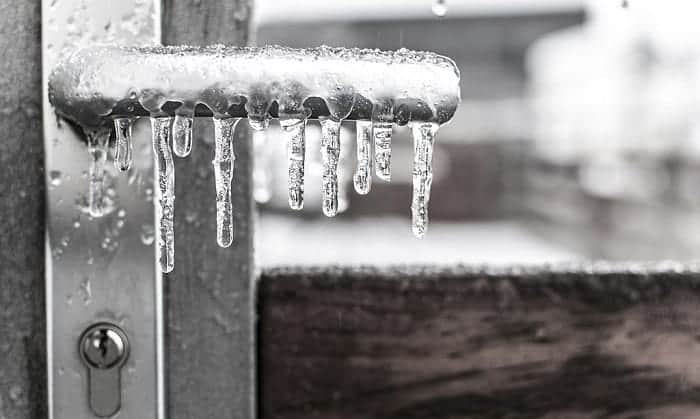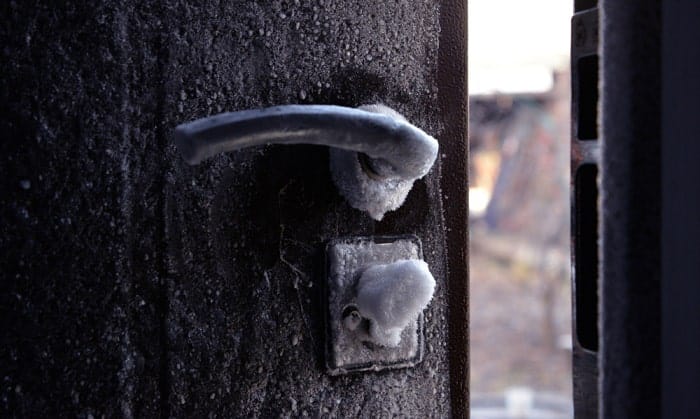The snow is falling outside, you’re strolling down the street and want to get home immediately so you can enjoy the cozy atmosphere created by the fireplace with a cup of hot chocolate. Unfortunately, the steam condenses in the lock, forcing it to freeze on its own and makes it impossible to insert the key.
How annoying and frustrating it is! But don’t worry because, with some preparation and a few standard tools, you will soon be able to prevent this. In today’s article, we will introduce you to a few methods of how to keep house door locks from freezing that you can equip yourself before winter approaches. In short, these are using:
- A storm door
- Magnets locks
- Lock lubricant
- Lighter, hairdryer, or torch
- Weatherproof padlocks
Nevertheless, please scroll down and read our brief guide for more suggestions.
Table of Contents
Why Does Your Lock Freeze
You might be surprised to find your lock frozen despite making sure that it is dry before you leave the house. Well, here is the scientific reason:
The proportion of relative humidity (RH), known as the humidity of the air, is the main factor behind this. High humidity combined with a very low temperature will cause water vapor to condense on your door lock when it hits the dew point that has not yet evaporated.
How to Keep House Door Locks from Freezing
1. Storm door
This is a strategy for controlling and dealing with severe weather outside. It is more helpful than you might think. In addition to being anti-snow, it resists UV rays, storms, rain, and wind by manipulating temperature adjustment mechanisms.
However, because of its flexibility, it might be inconvenient on the coldest days. It may warm your door but may not completely stop ice development. That is also the most significant limitation if your lock is frozen.
But don’t worry, we have a solution to this problem in the section below.
2. Magnet locks
Metal locks have a magnetic field so that they can be attached with magnets. Their function is to fill the space and prevent moisture from entering. All you have to do is make sure it is entirely dry before slipping it into the lock every time you leave the house. Merely take it off and keep it in a safe place when you return home.
The most important thing is choosing the appropriate size for them to fit snugly into the lock without letting any steam get in.
3. Lock Lubricant
It is perhaps the most controversial method. Lock lubricants come in different forms, including graphite, WD-40, hand sanitizer, or petroleum jelly… Since they are all alcohol-based, they are flammable and able to defrost. Using them frequently, on the other hand, might harm your lock by destroying the paint or causing it to lose its lubrication.
Many people still recommend this method because of its convenience. So, I think you should only use it in urgent cases and apply it in conjunction with other pre-emptive measures.
4. Socks
This method may sound weird but believe me, it is an effective way to keep padlocks from freezing. Choose a thick woolen winter sock that you no longer wear. Make sure your sock is always dry before twisting and tying the top back.
5. De-icing Spray
This is another approach that I highly recommend, but it requires some preparation in advance. After spraying directly into the keyhole, you will be able to see the difference in just a few seconds. Convenient, right?
When the weather starts to get cold, have a bottle or two in your house and your car. However, it is a temporary fix that will not be able to prevent water from entering your lock in the first place.
You also can use this de-icing spray to unfreeze your door lock even the car door lock.
6. Lighter, hairdryer, or torch
These are everyday items that we can find in the car or our bags and pockets. They are both heat-generating and safe. However, for absolute safety, this process may take a little longer.
You must heat the key before inserting it into the frozen lock. Repeat the process as needed because the heat generated is only temporary. Be careful, as you might get burned.
7. Weatherproof padlocks
This method is a bit expensive at first but will come in handy later on. Along with modern development, many locks are specially designed (For example, with non-revealing holes) to prevent environmental impacts, especially to lock anti-freeze.
It is probably the way to prepare in advance that I recommend most because, after all, prevention is better than cure, right?
8. Breath
That’s right, and you didn’t get it wrong. It is the way I recommend if you do not bring any of the above items. All you have to do is wrap your palm around the lock to make a range, then blow hot air into the hole to release the moisture.
This task requires a lot of patience. The process can take up to a few minutes to blow and re-insert the key a few times to check if it works.
Tips and Tricks for Higher Efficiency
- Do not rush. Stay calm and try some of the suggestions I made above. Any of these ways can thaw your locks in just a few minutes or less.
- Do not try to pour hot water into the lock, as that will solely cause the water to freeze back more quickly.
- Do not try to break the ice by repeatedly inserting the key. Your key can be bent or damaged if you force it.
- Do not wait until the issue arises. Make the best possible preparations for your circumstances and prevent it from happening in the first place.
- Do not throw the above items haphazardly and put them in a fixed and easy-to-find place, so you do not have to resort to the last option.
- Do not be afraid to communicate. Ask a neighbor for help, or save the phone number of a locksmith if you do not want to wait until the sun rises and the ice melts.
Conclusion
Having your lock freeze on a cold winter day is irritating and inconvenient. But since everyone, especially in cold-weather countries, have experienced this at least once, equipping yourself with the best preparation in the fall before winter arrives with the measures I mentioned above will save you from the hassle.
I’ve shared with you helpful tips and tricks on how to keep house door locks from freezing in the hopes of teaching you a thing or two about methods to keep locks from freezing conveniently and correctly. Leave your thoughts in the comments below. Send me an email if you want to explore any other subjects as well.

I am the last member to join Revolar and might be just the luckiest to work with dedicated people like Teddy and John. Our team has established a process where my only job is writing the best content to deliver incredible ideas and guides.





